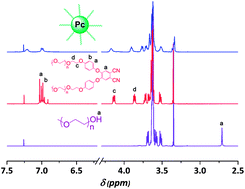Synthesis of water soluble PEGylated (copper) phthalocyaninesviaMitsunobu reaction and Cu(i)-catalysed azide–alkynecycloaddition (CuAAC) “click” chemistry†
Abstract
Octa-substituted

* Corresponding authors
a
Department of Chemistry, University of Warwick, Coventry CV4 7AL, UK
E-mail:
D.M.Haddleton@warwick.ac.uk
Fax: +44 24 7652 4112
Tel: +44 247652 3256
b
Unilever Research, Port Sunlight, Bebington, UK
E-mail:
Ezat.Khoshdel@Unilever.com
Fax: +44 151 6411843
Tel: +44 151 641 3253
Octa-substituted

 Please wait while we load your content...
Something went wrong. Try again?
Please wait while we load your content...
Something went wrong. Try again?
M. Li, E. Khoshdel and D. M. Haddleton, Polym. Chem., 2013, 4, 4405 DOI: 10.1039/C3PY00609C
To request permission to reproduce material from this article, please go to the Copyright Clearance Center request page.
If you are an author contributing to an RSC publication, you do not need to request permission provided correct acknowledgement is given.
If you are the author of this article, you do not need to request permission to reproduce figures and diagrams provided correct acknowledgement is given. If you want to reproduce the whole article in a third-party publication (excluding your thesis/dissertation for which permission is not required) please go to the Copyright Clearance Center request page.
Read more about how to correctly acknowledge RSC content.
 Fetching data from CrossRef.
Fetching data from CrossRef.
This may take some time to load.
Loading related content
